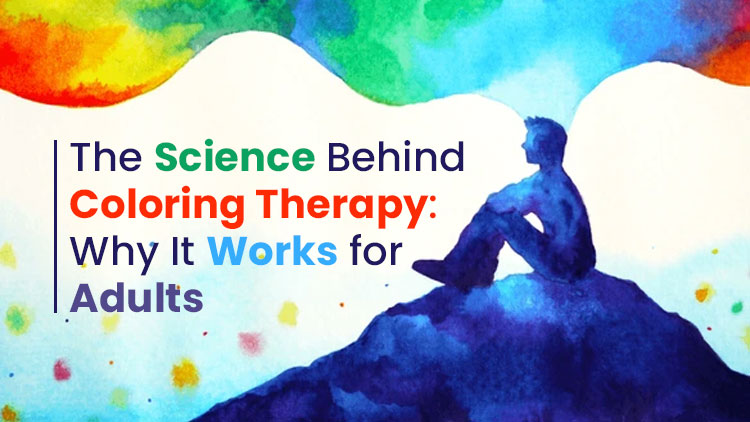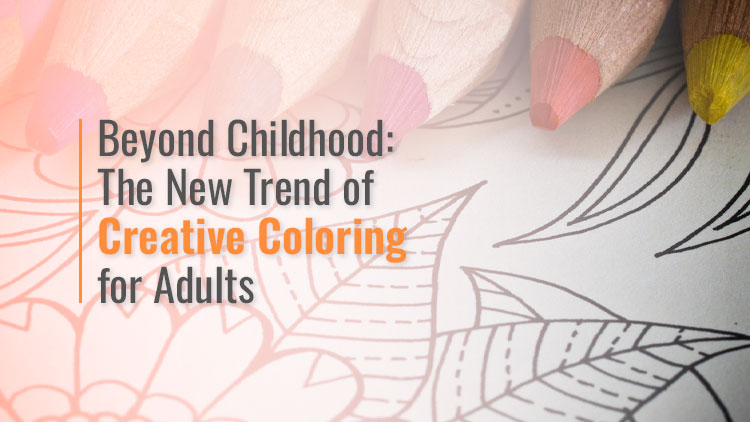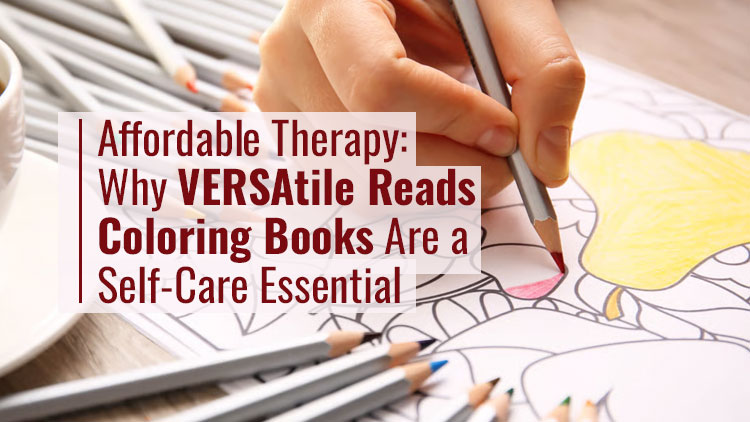
The Science Behind Coloring Therapy: Why It Works for Adults

The Science Behind Coloring Therapy: Why It Works for Adults
Introduction
With today’s fast-paced, technologically driven society, stress, anxiety, and burnout have become widespread among adults. Though some opt for old-school relief techniques such as exercise, meditation, or therapy, an unlikely but potent aid has risen to prominence in recent times: coloring therapy. Too often written off as a children’s hobby, coloring has turned into a scientifically backed adult therapy. From stress relief and improved concentration to mindfulness and emotional recovery, coloring therapy has a lot to offer. But what is it about this humble pastime that has such a potent effect?
If you’re looking to improve mindfulness, boost creativity, and enhance your well-being, VERSAtile Reads offers valuable insights and coloring products to help you on this journey. Exploring simple and effective coloring therapy can make a big difference in your daily life.
The Science Behind Coloring Therapy
1. The Psychological Benefits of Coloring
Coloring isn’t only an artistic activity—it’s a form of art therapy supported by psychology. Let’s dissect how it affects the mind:
Stimulates the Brain’s Reward System
When you color, your brain releases dopamine, a pleasure, motivation, and reward-associated neurotransmitter. This chemical reaction reduces feelings of depression and anxiety by giving you a sense of achievement and happiness.
Engages the Prefrontal Cortex
The prefrontal cortex is also the region of the brain that maintains higher-order functions such as problem-solving, decision-making, and attention. Coloring activates this area of the brain, which increases cognitive ability and mental acuity.
Induces a Meditative State
Coloring is also likened to meditation by psychologists. The repetitive action, with the requirement of attention to detail, causes people to concentrate on the present moment. This creates less negative thinking and emotional suffering.
Provides a Safe Emotional Outlet
For stressed or traumatized adults, coloring is an unspoken means of expression. Selecting colors and making patterns can be a representation of feelings, providing a secure environment to sort through emotions without the stress of words.
2. How Coloring Reduces Stress and Affects the Nervous System
One of the strongest impacts of coloring therapy is its capacity to decrease stress and soothe the nervous system. Let’s investigate the physiological principles behind this:
Activates the Parasympathetic Nervous System
As we color, our body moves out of the fight-or-flight (sympathetic nervous system) into the rest-and-digest state (parasympathetic nervous system).
Encourages Muscle Relaxation
The mundane hand movement that comes along with coloring aids in muscle relaxation, leaving the whole body relaxed. This relaxation of the body finds expression in a reduced stress mental state.
3. Increasing Focus, Creativity, and Intellectual Ability
Coloring is not only a stress-reduction activity—it’s a brain-enhancement activity as well.
Increases Attention Span
In a world of digital distractions, concentrating on one task such as coloring enhances the brain’s capacity to focus and remain present.
Enhances Problem-Solving Skills
Selecting colors and determining how to color complex designs involves decision-making and planning, which activates the logical part of the brain.
Stimulates Creativity
Meanwhile, the imaginative half of the brain is activated when selecting color schemes and playing with patterns. The two-way brain stimulation strengthens both analytical thought and imaginative expression.
Refines Motor Skills
The delicate motor actions entailed in coloring enhance hand-eye coordination, dexterity, and accuracy—abilities that benefit daily life.
4. Coloring as a Tool for Mindfulness and Emotional Healing
Mindfulness, the ability to remain fully present and engaged at the moment, is perhaps the most important mental health advantage of coloring.
Encourages Present-Moment Awareness
Coloring demands attention to detail, which keeps people grounded and focused on their actions instead of being overwhelmed by worries or regrets.
Reduces Rumination
Rumination—repeatedly reflecting on bad experiences—is a widespread trigger for anxiety and depression. Coloring breaks this cycle, shifting attention to a positive, structured task.
Encourages Emotional Balance
By being a judgment-free creative outlet, coloring enables people to work through emotions at their own speed, resulting in increased emotional stability.
Increases Self-Esteem
Successfully completing a coloring page provides a feeling of accomplishment and pride, increasing self-confidence and motivation.
Choosing the Right Coloring Patterns for Maximum Benefits
The type of coloring patterns selected can influence the overall therapeutic experience. Some of the most effective designs include:
- Floral and Nature Designs: Patterns inspired by nature, such as flowers, leaves, and landscapes, have a soothing effect on the mind. The organic shapes and gentle curves of these designs evoke feelings of peace and connection with the natural world.
- Geometric Patterns: Structured and orderly, geometric designs provide a sense of stability and predictability. The repetitive shapes and symmetry create a calming visual rhythm, helping to quiet the mind and improve focus.
- Dessert-Themed Patterns: Intricate designs featuring cakes, cookies, and pastries can be visually stimulating and comforting. These patterns evoke happy memories and a sense of indulgence, providing emotional relief and relaxation.
- Winter-Themed Designs: Snowflakes, icy landscapes, and cozy winter scenes can transport the mind to a tranquil, serene setting. The cool, crisp imagery promotes relaxation and a sense of calm, making it perfect for unwinding during colder months.
- Snakes and Reptile Designs: The detailed scales and twisting forms of snakes offer an intricate and engaging coloring experience. These designs can be both meditative and exciting, encouraging creativity and focus.
- Drinks and Beverages: Coffee cups, teapots, cocktail glasses, and smoothie jars create a fun and stylish coloring experience, making them ideal for relaxation and leisurely creativity.
- Candy and Sweets: Lollipops, cupcakes, candy canes, and chocolate bars offer a nostalgic and playful way to de-stress, adding an element of fun to the coloring process.
- Fantasy and Mythical Creatures: Dragons, unicorns, and fairies add an imaginative twist to coloring sessions, helping individuals escape into a whimsical world of creativity.
- Celestial and Space-Themed Patterns: Stars, planets, galaxies, and cosmic designs create a sense of wonder and tranquility, promoting a meditative and expansive mindset.
Summary
Coloring therapy offers numerous psychological and emotional benefits backed by science. It releases dopamine, the brain’s “feel-good” neurotransmitter, which enhances pleasure and motivation. By lowering cortisol levels and activating the parasympathetic nervous system, coloring helps reduce stress and promotes a state of calm. This creative activity also improves focus, cognitive function, and creative thinking by engaging both hemispheres of the brain. Furthermore, it encourages mindfulness by keeping individuals anchored in the present moment, which helps regulate emotions and reduces negative thought patterns. With repeated practice, coloring therapy fosters emotional healing, better stress management, and increased self-esteem, making it a simple yet powerful tool for overall well-being.
Conclusion
Coloring therapy is much more than just a fun pastime—it’s a robust therapeutic intervention grounded in psychology and science. By activating the brain’s reward system, lowering levels of stress hormones, and encouraging mindfulness, coloring provides adults with a novel and effective means of enhancing mental health. Whether you’re seeking stress relief, emotional balance, or a creative outlet, coloring therapy provides a safe, accessible, and enjoyable solution. So pick up those colored pencils and start your journey to a calmer, more focused you.
FAQs
1. Can coloring therapy alleviate anxiety and depression?
Yes. Coloring encourages mindfulness, decelerates rumination, and reduces cortisol levels, thus making it a valuable tool for stress and depression management
2. Which coloring books are ideal for stress relief?
Books with complex patterns, mandalas, and nature patterns are best. These demand concentration and repetition, which promote relaxation and focus.
3. How frequently should adults use coloring therapy?
Although occasional coloring is helpful, 15–30 minutes a day yields ongoing mental health benefits.
- Published Date:



